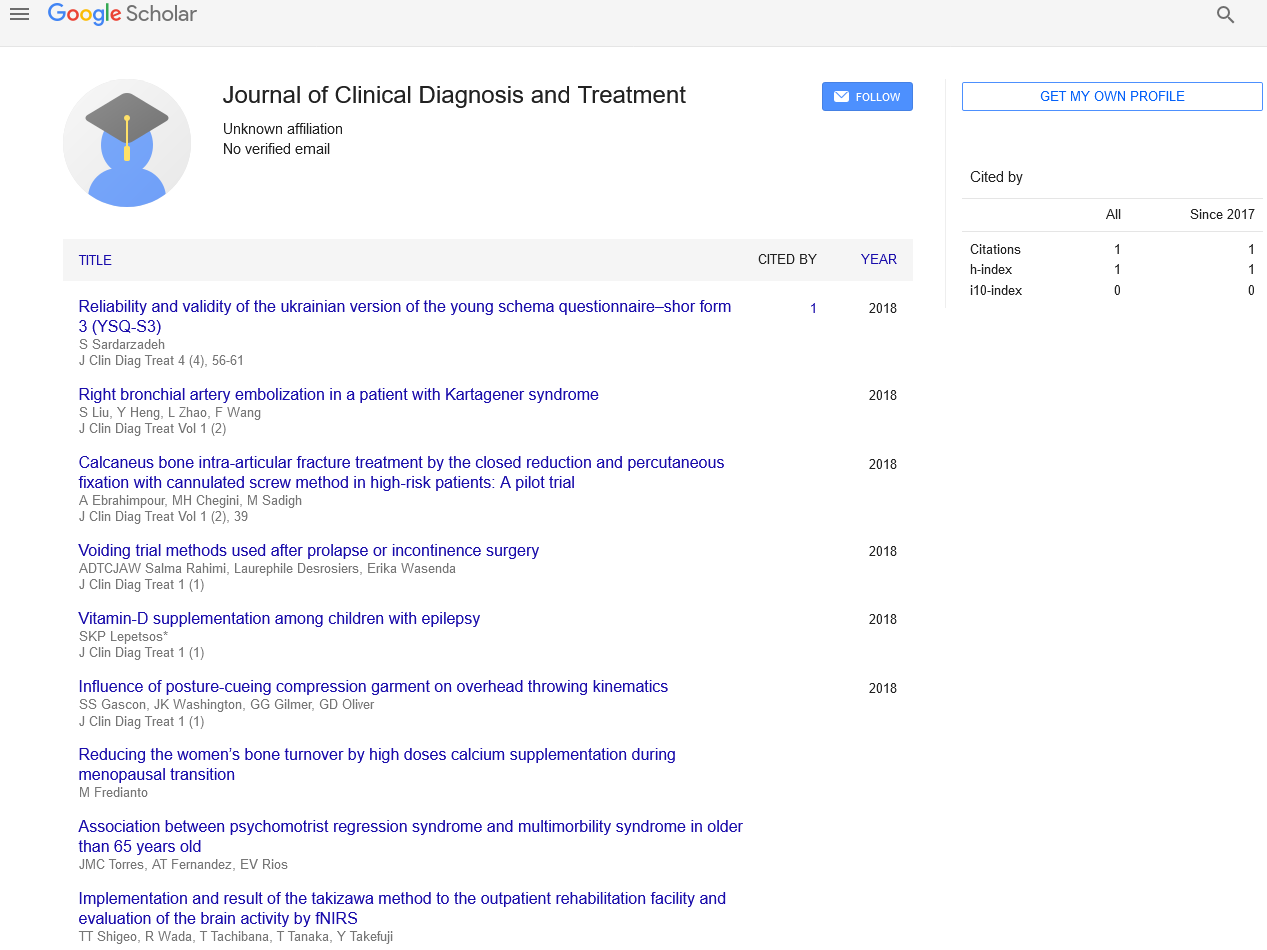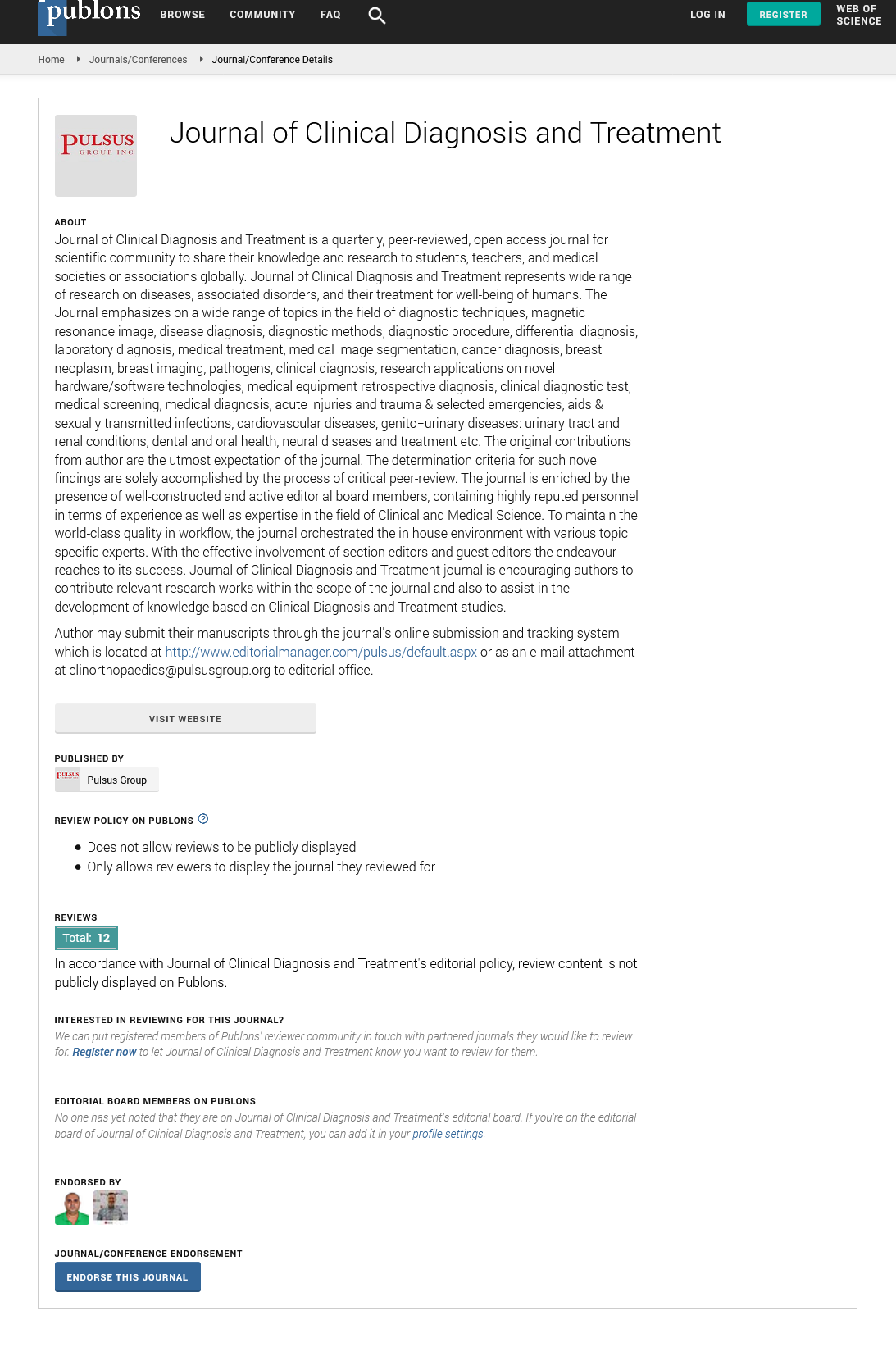Diagnostic Methods: Identification, Monitoring, Screening , Prognosis
Received: 03-Jul-2022, Manuscript No. puljcdt-22-5439; Editor assigned: 05-Jul-2022, Pre QC No. puljcdt-22-5439(PQ); Accepted Date: Jul 23, 2022; Reviewed: 12-Jul-2022 QC No. puljcdt-22-5439(Q); Revised: 21-Jul-2022, Manuscript No. puljcdt-22-5439(R); Published: 27-Jul-2022, DOI: 10.37532/puljcdt.22.4(4).9-10
Citation: Macy E. Diagnostic methods: Identification, monitoring, screening, prognosis.J Clin. Diagn. treat. 2022; 4(4)9-10
This open-access article is distributed under the terms of the Creative Commons Attribution Non-Commercial License (CC BY-NC) (http://creativecommons.org/licenses/by-nc/4.0/), which permits reuse, distribution and reproduction of the article, provided that the original work is properly cited and the reuse is restricted to noncommercial purposes. For commercial reuse, contact reprints@pulsus.com
Abstract
According to medical terminology, neurological disorders are conditions that affect the spinal cord, brain, and body's nerves. A variety of symptoms can be caused by structural, metabolic, or electrical abnormalities in the brain, spinal cord, or other nerves. Paralysis, weak muscles, shaky coordination, loss of feeling, convulsions, confusion, pain, and altered degrees of consciousness are a few symptoms.
Keywords
Neurological disorders; Convulsions, Neuropsychology; Huntington's disease
Introduction
To determine what sickness, malfunction, condition, or affliction is affecting a person, diagnostic techniques are performed. These methods are employed to reduce the range of potential diagnoses before making a decision. After basic screening tests are carried out, it is frequently impossible to make a definitive diagnosis. These are the times when additional diagnostic testing will be done. After screening tests, diagnostic imaging tests are the most often utilized procedures. The major use of diagnostic tests is to identify diseases, their prognoses, and the extent to which they have spread throughout the body. It determines which illness or condition accounts for a person's symptoms and indicators. It is most frequently referred to as a diagnostic, with the implied medical context. The history and physical examination of the patient who is seeking medical attention usually yield the data needed for diagnosis. The process frequently includes one or more diagnostic procedures as well, such as medical tests. Due to the vague nature of many indications and symptoms, diagnosis is frequently difficult. For instance, skin redness is a marker of various illnesses and cannot, by itself, inform a healthcare practitioner what is wrong. Therefore, it is necessary to make a differential diagnosis, which involves contrasting and comparing several theories.
The following uses for diagnostic testing are listed:
Identification
Following a physical examination, medical history review, and evaluation of your signs and symptoms, your doctor will want to know what is causing your symptoms, whether they are a direct result of a specific disease or a consequence of your disease process.
By ordering diagnostic testing, they will want to either confirm a suspected ailment or rule out other conditions. Diagnostic tests can aid your doctor in making an early diagnosis, allowing them to begin treatment right away and stop the disease's progression.
Monitoring
Your doctor might advise a wait-and-watch strategy if you have been diagnosed with a certain medical condition or disease. This type of therapy strategy is used to treat conditions like fibroid and some types of cancer.
Screening
When a person does not exhibit any symptoms of a condition, a screening test is performed to look for probable disorders or illnesses. You might inquire with your physician about undergoing a condition screening test.
Prognosis
A diagnostic test can also assist your doctor in determining the course of your illness and estimating your life expectancy. Some Diagnosis tests are as follows:
Colonoscope
A flexible tube called a colonoscope is used during a colonoscopy. It is inserted through your rectum and anus. It enables your physician to view the interior of your big bowel (the colon). Images from the tube are sent to a screen so that symptoms of medical disorders can be viewed there. The colonoscope is a long, flexible tube with a thin wall. It is equipped with a camera and light to allow for close inspection of the bowel. It is pliable and adaptable to bends. This permits it to move throughout your colon.
Biopsy
During a biopsy, a small sample of tissue is removed from the body for testing. This aids in disease diagnosis. There are numerous applications for biopsies. They may be carried out to determine whether a lump is malignant or not. They also occasionally look for issues like liver or kidney disorders. They can be used to determine if a condition is improving or deteriorating. Doctors can make the best treatment decisions with the aid of biopsies.
CT scan
that produces 3-dimensional images of your body's bones, tissues, organs, and tumours. The device revolves around you while taking xrays of incredibly thin slices of your body to provide a cross-sectional image. A CT scan, also known as computed tomography, is a type of x-ray
Compared to a 2-dimensional x-ray, a CT scan offers additional viewpoints and a great deal more detail. When your doctor wants to observe soft tissues in your body that don't always show up on x-rays, they could be utilized instead of an x-ray. It aids in the diagnosis of medical disorders and aids in the planning of medical care, for instance, when someone sustains internal injuries in an accident.
Electroencephalogram
The test that analyses the electrical activity of the brain is called an electroencephalogram, or EEG. It can be used to identify or track brain-related illnesses like epilepsy and sleep disturbances. The need for an EEG will be communicated to you by your doctor.
Gastroscopy
Upper endoscopy, commonly referred to as gastroscopy, is the use of an endoscope, a thin, flexible tube, to examine the upper digestive tract. To observe these places, a tube is put into the mouth, passed into the oesophagus, stomach, and first segment of the small intestine (duodenum). A video camera and light are included into the endoscope, which sends images to a monitor so a doctor may view them. A gastroscopy is typically performed to examine symptoms like heartburn, nausea, or trouble swallowing. It can demonstrate the presence of swelling, an ulcer, a polyp, or other development.
Why Diagnostic test is essential?
Diagnostic testing, which includes imaging, biochemical, pathologic, and psychological evaluations, discloses symptoms and signs that are used to direct medical examination. There aren't many tests that can determine whether you have a disease. Diagnostic tests are typically used to find, identify, and monitor the development of disease symptoms. Doctors must comprehend how test results impact the likelihood that a disease is present in order to make the greatest use of diagnostic testing. Diagnostic tests must have the capacity to transform the pre-test likelihood of disease into the post-test likelihood, which must be more certain. Diagnostic tests should take a logical path that either confirms the diagnosis or eliminates it in order to reach a sufficiently high likelihood of disease.






